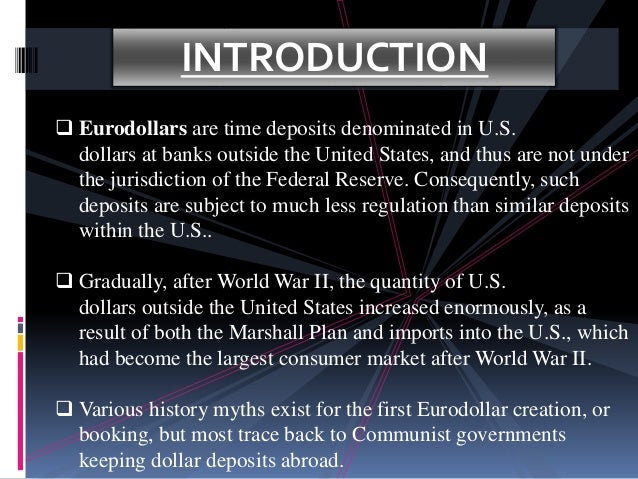When our clients see Eurodollars futures being traded in their CTA accounts, they sometimes think that it is the Euro/USD currency pair. Eurodollars actually have nothing to do with Europe’s currency. Eurodollars are interest bearing bank deposits denominated in US Dollars and held at banks outside of the United States. Since these bank deposits are held outside the U.S., they are outside the jurisdiction of the US Federal Reserve, and subject to less regulation. Due to this, the higher level of risk to investors is reflected in higher interest rates.
The Eurodollar Futures contract started trading on the Chicago Mercantile Exchange (CME) in 1981, marking the first cash settled futures contracts. When Eurodollar futures contracts expire, the seller of the contract can transfer the associated cash position rather than making delivery of the underlying asset.
- Eurodollars are deposits of US dollars in banks outside of the United States – typically in Europe (hence the name). As the deposit is made outside of the US it escapes banking regulations from the Federal.
- The European Currency Unit (more commonly known as the eurodollar or ' eddies ' for short, though also referred to as: euro, holos, color, new script, white/white script, Ebucks, or Smuggies) is the primary.
- Eurodollar is a term that refers to any United States dollar (“U.S. Dollar”) held outside the U.S. In other words, there can be Eurodollars in the UK, the UAE, Brazil, Burundi, etc.
What do Eurodollar futures measure? The underlying instrument in Eurodollar futures is a eurodollar time deposit having a principal value of $1,000,000 with a three-month maturity. Eurodollar futures provide an effective means for companies and banks to secure an interest rate for money it plans to borrow or lend in the future. The Eurodollar contract can be used to hedge against interest rate changes over multiple years into the future. If interest rates rise, Eurodollar futures decrease, and if interest rates fall, Eurodollar futures increase. Here is a current chart of December 2018 Eurodollar futures:


Reflecting market expectation for interest rates, Eurodollar futures are a global benchmark and a fundamental building block of the interest rate marketplace, while options on Eurodollar futures are. The time interval eurodollar refers to U.S. Dollar-denominated deposits at worldwide banks or on the overseas branches of American banks. On account of they’re held exterior America, eurodollars are.
Eurodollars Inflation
As you can see Eurodollars futures are currently trading around 97.40, which implies an interest rate of 2.60% in December 2018. If expected eurodollar interest rates in December 2018 were to rise to 3.60%, then December 2018 Eurodollars futures contracts would be trading down around 96.40.

Eurodollars Symbol
As an interest rate product, the policy decisions of the US Federal Reserve have a major impact on the price of Eurodollar futures. Trading Eurodollar futures can be quite volatile around FOMC meetings and announcements. A long-term change in Fed policy towards raising interest rates would lead to Eurodollar futures declining steadily over the long-term (making it a good trade for trend followers).